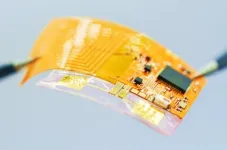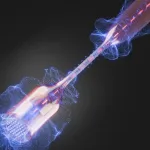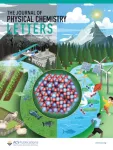(Press-News.org) We tend to separate the brain and the muscle—the brain does the thinking; the muscle does the doing. The brain takes in complex information about the world and makes decisions, and the muscle merely executes. This has also shaped how we think about a single cell; some molecules within cells are seen as ‘thinkers’ that take in information about the chemical environment and decide what the cell needs to do for survival; separately, other molecules are seen as the ‘muscle,’ building structures needed for survival.
But a new study shows how the molecules that build structures, i.e, the muscle, can themselves do both the thinking and the doing. The study, by scientists with the University of Chicago, California Institute of Technology, and Maynooth University, was published Jan. 17 in Nature, and may suggest avenues for new ways to think about computation using the principles of physics.
“We show that a natural molecular process—nucleation—that has been studied as a ‘muscle’ for a long time can do complex calculations that rival a simple neural network,” said UChicago Assoc. Prof. Arvind Murugan, one of the two senior co-authors on the paper. “It’s an ability hidden in plain sight - the ‘doing’ molecules can also do the ‘thinking.’ Evolution can exploit this fact in cells to get more done with fewer parts, with less energy and greater robustness.”
Thinking using physics
To survive, cells need to recognize the environment they are in and respond accordingly. For example, some combinations of molecules might indicate a time of stress that requires hunkering down, while other combinations of molecules might indicate a time of plenty. But the difference between these molecular signals can be subtle—different environments might involve the same molecules but in different proportions.
Constantine Evans, the lead author of the study, explained that it is a bit like walking into a house and smelling freshly baked cookies, versus smelling burning rubber. “Your brain would alter your behavior depending on you sensing different combinations of odorful chemicals,” he said. “We set out to ask if just the physics of a molecular system can do the same, despite not having a brain of any kind.”
The traditional view has been that cells might be able to sense and respond in this way using molecular circuits that conceptually resemble the electronic circuits in your laptop; some molecules sense the amount of salt and acid in the environment, other molecules make a decision on what to do, and finally ‘muscle’ molecules might carry out an action in response, like building an internal protective structure or a pump to remove unwanted molecules.
Murugan and his colleagues wanted to explore an alternative idea: that all of these tasks—sensing, decision making, response—can be accomplished in one step by the physics inherent to the ‘muscle’ molecules that build a structure.
They did so by working with the principle of “phase transitions.” Think of a glass of water freezing when it hits 32F; first, a little fragment of ice ‘nucleates,’ and then grows out until the whole glass of water is frozen.
On the face of it, these initial steps in the act of freezing—called ‘nucleation’ in physics—does not resemble ‘thinking’. But the new study shows that the act of freezing can “recognize” subtly different chemical combinations—e.g., the smell of oatmeal raisin cookies versus chocolate chip—and build different molecular structures in response.
Robustness in experiments
The scientists tested the robustness of ‘phase transitions’-based decision-making using DNA nanotechnology, a field that Erik Winfree (BS’91) helped pioneer. They showed that a mixture of molecules would form one of three structures depending on what concentrations of molecules were present in the beaker.
“In each case, the molecules came together to build different nanometer-scale structures in response to different chemical patterns – except the act of building the structure in itself made the decision on what to build,” Winfree said.
The experiment revealed that this ‘muscle’-based decision making was surprisingly robust and scalable. With relatively simple experiments, the researchers could solve pattern recognition problems involving about a thousand kinds of molecules—nearly a 10-fold larger problem than had been done previously using other approaches that separated ‘brain’ and ‘muscle’ components.
The work points at a new view of computation that does not involve designing circuits, but rather designing what physicists call a phase diagram. For example, for water, a phase diagram might describe the temperature and pressure conditions in which liquid water will freeze or boil, which are ‘muscle’-like material properties. But this work shows that the phase diagram can also encode ‘thinking’ in addition to ‘doing,’ when scaled up to complex systems with many different kinds of components.
“Physicists have traditionally studied things like a glass of water, which has many molecules, but all of them are identical. But a living cell is full of many different kinds of molecules that interact with each other in complex ways,” said coauthor Jackson O’Brien (PhD’21), who was involved in the study as a UChicago graduate student in physics. “This results in distinct emergent capabilities of multi-component systems.”
The theory in this work drew mathematical analogies between such multi-component systems and the theory of neural networks; the experiments pointed to how these multi-component systems can learn the right computational properties through a physical process, much like the brain learns to associate different smells with different actions.
While the experiments here involved DNA molecules in a test tube, the underlying concepts—nucleation in systems with many kinds of components—applies broadly to many other molecular and physical systems, the authors said.
“DNA lets us experimentally study complex mixtures of thousands of kinds of molecules, and systematically understand the impact of how many kinds of molecules there are and the kinds of interactions they have, but the theory is general and should apply to any kind of molecule,” explained Winfree.
“We hope this work will spur work to uncover hidden ‘thinking’ abilities in other multi-component systems that currently appear to merely be ‘muscles,’” said Murugan.
END
UChicago, Caltech study suggests that physical processes can have hidden neural network-like abilities
2024-01-18
ELSE PRESS RELEASES FROM THIS DATE:
Wireless drug patch shows promise as chronic disease treatment delivery system
2024-01-18
CHAPEL HILL, NC – University of North Carolina at Chapel Hill scientists created a new drug delivery system, called the Spatiotemporal On-Demand Patch (SOP), which can receive commands wirelessly from a smartphone or computer to schedule and trigger the release of drugs from individual microneedles. The patch’s thin, soft platform resembles a Band-Aid and was designed to enhance user comfort and convenience, since wearability is a crucial factor for chronically ill patients.
The research team, led by Juan Song, PhD, professor of pharmacology ...
AI can boost service for vulnerable customers
2024-01-18
AUSTIN, Texas –– Artificial intelligence has become the Swiss Army knife of the business world, a universal tool for increasing sales, optimizing efficiency, and interacting with customers. But new research from Texas McCombs explores another purpose for AI in business: to contribute to the social good.
It can do so by helping businesses better serve vulnerable consumers: anyone in the marketplace who experiences limited access to and control of resources.
“AI is widely recognized for its operational and ...
Structural study points the way to better malaria drugs
2024-01-18
Structural insights into a potent antimalarial drug candidate’s interaction with the malaria parasite Plasmodium falciparum have paved the way for drug-resistant malaria therapies, according to a new study by researchers at Weill Cornell Medicine and Van Andel Institute.
The antimalarial molecule, TDI-8304, is one of a new class of experimental therapeutics that targets the proteasome, an essential, multiprotein complex in P. falciparum cells. Two years ago, the researchers showed in a preclinical study that TDI-8304 potently kills malaria parasites at multiple stages of their life cycle and ...
VCU research promotes a business paradigm shift that emphasizes people, not just profit
2024-01-18
RICHMOND, Va. (Jan. 18, 2024) – New research from Virginia Commonwealth University fundamentally challenges the paradigm that business organizations should promote profit above all else.
Christopher S. Reina, Ph.D., executive director of the VCU Institute for Transformative Leadership, lays out the foundation for transforming business to be much more people-centered and humanistic in “Humanistic Organizing: The Transformative Force of Mindful Organizational Communication.” ...
Towards the quantum of sound
2024-01-18
The quantum ground state of an acoustic wave of a certain frequency can be reached by completely cooling the system. In this way, the number of quantum particles, the so-called acoustic phonons, which cause disturbance to quantum measurements, can be reduced to almost zero and the gap between classical and quantum mechanics bridged.
Over the past decade, major technological advances have been made, making it possible to put a wide variety of systems into this state. Mechanical vibrations oscillating between ...
NFL PLAY 60 launches Fitness Tracking Competition to help students get daily minutes of movement
2024-01-18
DALLAS, January 17, 2024 — The American Heart Association and National Football League are asking classrooms, afterschool programs and other student groups to join the NFL PLAY 60 Fitness Tracking Competition from Jan. 22 to Feb. 9. The classroom with the most activity minutes in each of the 32 NFL club markets will receive a $1,000 grant with an additional $1,000 PLAY 60 grant awarded to the top classroom overall. The competition and the goal of NFL PLAY 60 is to increase physical activity in kids which impacts overall mental and physical wellness which is essential to help children reach their full potential.
The NFL PLAY 60 Fitness Tracking Competition takes place ...
Using magnetized neurons to treat Parkinson’s disease symptoms
2024-01-18
Electrical deep brain stimulation (DBS) is a well-established method for treating disordered movement in Parkinson’s disease. However, implanting electrodes in a person’s brain is an invasive and imprecise way to stimulate nerve cells. Researchers report in ACS’ Nano Letters a new application for the technique, called magnetogenetics, that uses very small magnets to wirelessly trigger specific, gene-edited nerve cells in the brain. The treatment effectively relieved motor symptoms in mice without damaging surrounding ...
How does one species become many?
2024-01-18
Evolutionary biologists have long suspected that the diversification of a single species into multiple descendent species – that is, an “adaptive radiation” – is the result of each species adapting to a different environment. Yet formal tests of this hypothesis have been elusive owing to the difficulty of firmly establishing the relationship between species traits and evolutionary “fitness” for a group of related species that recently diverged from a common ancestral species.
A global team of biologists led by McGill University have compiled nearly two decades of field data – representing the study ...
St. Jude Children’s Research Hospital adds $13 million project to Research Collaboratives Program
2024-01-18
(MEMPHIS, Tenn., January 18, 2024) St. Jude Children’s Research Hospital today announced a nearly $13 million investment toward a new research collaboration with scientists at Columbia University, Duke University and Stanford University to expand the understanding of G-protein coupled receptors (GPCR), which are vital proteins that impact human health and disease.
The collaborative research project is led by two St. Jude researchers, Scott Blanchard, Ph.D., and M. Madan Babu, Ph.D., who are working with Nobel laureate and Howard Hughes Medical Institute investigator Robert Lefkowitz, M.D., of Duke University; Jonathan Javitch, M.D., Ph.D., of ...
Efficiently moving urea out of polluted water is coming to reality
2024-01-18
WPI Researchers have developed a material to remove urea from water and potentially convert it into hydrogen gas. By building these materials of nickel and cobalt atoms with carefully tailored electronic structures, the group has unlocked the potential to enable these transition metal oxides and hydroxides to selectively oxidize urea in an electrochemical reaction.
The study, led by Xiaowei Teng, the James H. Manning professor of Chemical Engineering at WPI, was recently published in the Journal of Physical Chemistry Letters and highlighted in the publication’s supplementary front cover.
The ...



